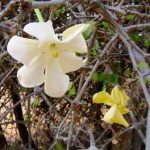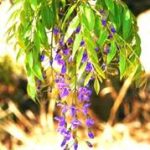TREE LIFE
December 1982
MASHONALAND CALENDAR
Saturday December 4th : National Tree Planting Day
Tuesday December 7th : Botanic Garden Walk. Meet in the car park at 1645 hours for 1700 hours.
Sunday December 19th : Craig Hill. 1000 hours onwards. All welcome. Tea and coffee will be available all day, so come when you please and leave when you like.
Sunday January 16th : Serui River. 2nd crossing just beyond Selous, 76.5km along the Chegutu road. A spot we have driven past on three occasions this year and it is well worth stopping at. With an altitude of 1213m there is a combination of lower altitude and riverine vegetation. Trees such as Terminalia randii, small leaved Terminalia, Tarchonanthus camphoratus, wild camphor, Bolusanthus speciosus, wild wisteria are some of the interesting trees we do not often see. There are patches of mopane with that special atmosphere and I hope we shall lunch under an Afzelia quanzensis, Pod Mahogany, with a trunk which will take at least three people with arms outstretched to measure the circumference.
Tuesday January 25th : Annual General Meeting.
Notice is hereby given that the 33rd Annual General Meeting of the Tree Society of Zimbabwe will be held on Tuesday 25th January 1983 at 2000 hours at the Selborne-Routledge School.
The Agenda will be included in the next Newsletter as only 14 days notice is required for that. If any member wishes to propose any resolution please will they do so in writing not less than 21 days before the meeting. As I mentioned last year I shall formally propose that the Constitution be amended under 15. Rules for Branches of the Society to read “The affairs of a Branch shall be managed by a committee consisting of not less than two members” with the appropriate deletion of course. This will allow the Branches to continue as they are but to do so constitutionally. I am mentioning this now so that if anyone would like to discuss the matter or make any suggestions they can do so before a formal resolution is presented.
NOVEMBER 1982 BOTANIC GARDEN WALK
At this time of the year it is always interesting to see what is flowering in the Botanic Gardens and so this was the theme for our November walk. And that raised the question: What makes a tree flower? The answer is simple – hormones. However, a variety of factors combine to trigger off the hormone activity. These include temperature moisture, past and present, and the natural cycle of events. We have an Ochna schweinfurthiana in our garden which invariably flowers during the period 19 – 24 October. The Winter Cassia, Cassia singueana were very early this year but last year did not flower until mid-July. Examples of the consistent and the variable.
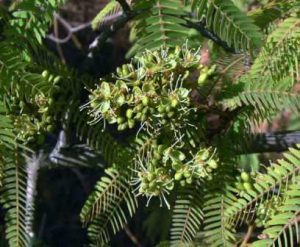
Brachystegia microphylla flowers. Photo: Rob Burrett. Source: Flora of Zimbabwe
As Tom said not all the trees have big beautiful flowers which look like tulips, never the less they were all of interest. Our first stop was at Brachystegia microphylla, flowering for the first time. These were planted in 1964 from seed collected by the late Prof. H. Wild on the eastern slopes of the Chimanimani mountains, bordering on areas of rain forest. This species also occurs in Zambia in the higher rainfall areas, southern Zaire, Malawi and southern Tanzania. It resembles Brachystegia glaucescens, Mountain acacia, but has 25 to 55 pairs of very small leaflets whereas the latter only has up to 12 pairs which are much larger. Rinorea ilicifolia was first recorded in this country when Tom collected the two seedlings whose flowers we admired. As a member of the VIOLACEAE family it could be expected to have showy flowers. However, they were only about 9mm long but there was no doubt about the holly like leaves; “ilicifolia” means with leaves like Ilex (holly).
A lovely sight was Cladostemon kirkii. This is a fascinating flower with two showy petals, white to yellowish crimped and clawed and 2 smaller insignificant petals and a long androgynophore. This character appears to be common to the other members of the family CAPPARACEAE as well. The female parts of the flower consist of a stigma the pollen receiving organ, a style which carries the stigma and an ovary which if fertilized becomes the seed. The whole is called a pistil or gynoecium and if borne on a stalk the stalk is called a gynophore. The male parts of the flower are the stamens or androecium comprising the filaments with the anthers, the pollen producing organs, at the end. An androphore is the stalk which carries the stamens and when there is a common stalk for both the pistil and the stamens it is known as an androgynophore. The androgynophore of Cladostemon is very conspicuous being up to 15cm long and extending beyond the petals. The stamens occur about ¾ of the way along with the pistil at the end. The fruit therefore develops at the end of this long stalk. Cladostemon which is digitately trifoliate, hence the name Three finger bush, is an inhabitant of low altitude areas in the north east and south east of the country. With its showy golden-yellow flowers Rhigozum brevispinosum was most attractive. This is a drought adapted plant as to be expected with something which grows between Plumtree and Beit Bridge Gardenia gummiflua seen on the last walk was in full bloom and heavily scented.
Also now fully open was Strophanthus kombe with the ends of its petals drawn out into long threads and looking as though someone had decorated the flowers with fine streamers. It is also found in low altitude, low rainfall areas and is best described as a scrambler. Coffea racemosa, another inhabitant of hot, dry, low altitude areas was most attractive in yellow leaf and pink flower. This is a member of the same genus as Coffea arabica from which man has obtained coffee since the middle ages.
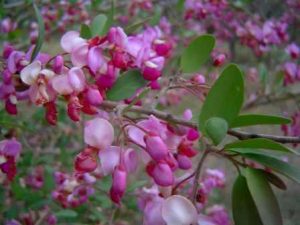
Securidaca longepedunculata flowers. Photo: Bart Wursten. Source: Flora of Zimbabwe
Securidaca longepedunculata, wild violet tree, occurring naturally was a lovely site. Mrs. Eileen McBean is noted for the success she has had germinating the seed and her formula was repeated for our benefit : The seed should be planted on top of a cow pat and for preference, of course, the pat should have come from a jersey cow. Once germinated the roots should not be disturbed. And whence the name? It comes from the Latin “secures” a hatchet or axe which refers to the shape of the winged fruit. The specific name is almost self explanatory and refers to the long peduncle or flower stalk and finally we had a look at Brachystegia glaucescens flowering for the first time having been planted in 1965.
During the walk Tom reminded us of a tip he has given us before and which I think bears repeating and remembering and using. Albizias have just one gland on the petiole usually in the middle of the petiole, the half way house position, while those on the Acacias are variable in position and number and may even be absent. If only we had remembered this at Stanley Farm, Chegutu.
Thank you Tom for showing us the flowers and for the reminder that glands are an aid to identification and for which we should remember to look.
SPRINGS FARM, SUNDAY 21ST NOVEMBER 1982
The weatherman really is very good to us. On Sunday 21st November it could have been hot and it was, it could have rained and it did. But the heat was relieved by cloud and a cool breeze and the rain only fell in the form of a light drizzle once we had all gathered at the bus to go home.
One cannot visit Springs Farm and not take the opportunity to wander around Ian Turner’s garden as Ian grows all the unusual plants; ferns and tree ferns, palms and pot plants, not in pots but on moss covered stumps and in the open, aloes and cycads and some unusual indigenous trees have found a niche for themselves in these ideal conditions. We saw Diospyros whyteana, bladder-nut in green fruit which looks like large ribbed gooseberries; Diospyros natalensis, acorn diospyros or tickey tree, much bigger than we usually expect to see and Ekebergia capensis, dog plum, with its slightly winged rachis and curved lanceolate leaflets; all inhabitants of a higher moisture environment.
Ferns are spore bearing plants known as PTERIDOPHYTA while most of the plants we know are SPERMATOPHYTA or seed bearing. Cycads can be described as living fossils or the coelacanths of the plant world. They are the most primitive of the living seed bearing plants and are known to have been flourishing about 150 million years ago. These days their numbers have dwindled and there are a mere 3 families, CYCADACEAE, ZAMIACEAE and STANGERIACEAE with 10 genera and about 150 species which are still in existence. The genus indigenous to this country is Encephalatos in the family ZAMIACEAE. They bear seeds and so belong to the plants known as SPERMATOPHYTA. However, they bear cones with naked seeds and so come into the sub-group known as Gymnospermae (gymnos comes from Greek and means naked or uncovered). In this group are also the family CUPRESSACEAE represented by Widdringtonia and PODACARPACEAE the Yellowwood family. The other sub group are the Angiospermae which are plants that bear flowers and produce seeds in a covered case, the ovary. The origin of the word also from Greek, anggeion, a vessel and sperma, a seed. When a seed germinates usually two leaves appear first, these are the cotyledons and because there are two the plants are known as Dicotyledons and form one group of Angiospermae. The other group are the Monocotyledons which only have one cotyledon and in this group are grasses, palms, Draceanas, Ensetes, Strelitzias and the lily family, LILIACEAE which includes the aloes. Not so familiar to us is the family BROMELIACEAE, also monocotyledons which are all tropical species, all 1400 of them and, as we saw at Springs, of infinite variety.
The best known member of that family is, of course, the pineapple. There was a Baobab doing very nicely which Ian had found as a seedling in his own compound, the fruit no doubt brought back by employees returning from leave, eaten and the seed thrown away.
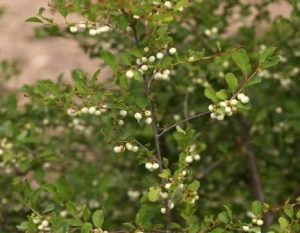
Securinega virosa. Photo: Bart Wursten. Source: Flora of Zimbabwe
We returned to the bus and traveled round to the base of a hill to look at natural vegetation. We were greeted by the lovely green of freshly clothed Securinega virosa, snowberry tree, in minute white bud. This was one of the variable species of the day as we encountered it frequently and the leaves were in various stages of development so that it looked different each time and caused confusion. Although this is a member of the family EUPHORBIACEAE it does not have a milky sap and the fruit is a single white berry and not 3-lobed.
After the comments on glands at the last Botanic Garden Walk we specially looked out for them and set out to prove that Albizias have a gland in the middle of the petiole or leaf stalk and with Acacias the position of the glands is variable. Acacia amythethophylla, large-leaved Acacia, was the first to present itself. Many of the leaves were freshly opened and did not have any glands at all. However we did find some older leaves with a very conspicuous gland at the base of the petiole and another between the top pair of pinnae. This is one way of distinguishing A. amythethophylla from Peltophorum africanum, African wattle, which does not have glands but does have distinctive fern-like stipules at the base of the petiole lying along the stem and rusty coloured shoots. It is also unarmed (without spines) as is Albizia amara. This did have glands, albeit minute and hardly developed, in the right place. Albizia antunesiana, purple leaved Albizia did not follow the rule as its very conspicuous glands were at the base of the petiole. However, that has comparatively large leaflets and it is unlikely that one would confuse it with an Acacia. So perhaps it was the fine leaved Albizias to which Tom was referring. The presence of the glands distinguishes this from Burkea africana, which, of course has the velvet tips to the branches to confirm the difference. Because we were examining the leaves closely we saw the small secondary stipules or stipels at the base of the first pair of leaflets. This has been pointed out on Albizia versicolor, poison-pod Albizia but I have not noticed them on Albizia antunesiana before, nor is there any mention of them in the literature. A very distinctive feature is the pale under surface of the leaves and the purple bloom which is often present especially on younger plants.
Another tree with very pale under surface was Lannea discolor. Discolor should be interpreted as meaning different colours although we could have been forgiven for thinking it referred to off-white or stained as the leaves on the tall trees were so covered with hairs that they appeared off-green from below. The common name is Live-long, although if translated from the Shona Mugan’cha it should be Never-die and refers to the ability of the tree to regenerate if chopped down and the rapidity with which truncheons strike.
Acacia karroo, sweet thorn with its rusty stems we identified without any doubt, although the leaflets were smaller than usual. No one could find more than 7 pairs of pinnae and A. rehmanniana has a minimum of 15 pairs. I did not notice any glands at the time but have since had a look with a lens and found glands on the rachis between the pinnae but seldom on the petiole although I understand that they can be present there.
Having reached this point I decided the time had come to look up the definition of a gland. Each glossary differs slightly but it appears that a gland is a secreting organ (in one place described as an extra-floral nectary) on the surface or embedded in a leaf, flower etc. or raised on a small stalk or it may be a warty protuberance. No reference is made to their purpose other than as an aid to identification and I am quite sure that was the purpose for which nature included glands on plants.
We had lunch under an enormous Msasa which was vast enough to provide shade for us all and then the bus took us to Ewanrigg where Mr. John Smith-Wright very kindly took us round the Herb Garden telling us of the lore and legend of the herbs growing there. We were encouraged to feel and smell and some people even tasted and many of us came away with seeds and cuttings to try and grow the herbs for ourselves.
A lovely day with a difference. A big thank you to Mr Ian Turner and Mr John Smith-Wright for sharing your plants and your knowledge of them with us – and thank you Mr. Weatherman for allowing them to do so!
MATABELELAND BRANCH
Sunday December 5th : Notice is hereby given that the AGM of the Matabeleland Branch will be held at 6 Caithness Road, Hillside at 1000 hours. Please make every effort to attend.
And since this is the last Newsletter before Christmas I should like to take this opportunity of wishing you all and your families a very Happy Christmas from Paul and myself.
-Meg Coates Palgrave; Chairperson
NATURE INTERTWINED
The identification of trees and plants is no easy matter for the layman. However, if a real interest is taken and keen observations made the task becomes easier and infinitely more interesting. Habitats, such as granite kopjes, river banks or open woodland; seasonal variations such as spring or autumn leaf colours, as well as the times of flowering (for instance our Proteas and the two commonest Cassias can easily be identified by the time at which they flower); altitude can often be critical and the general shape or field impression of the tree, often scorned by the botanist who has long passed that stage, but so helpful to the beginner. One of the most beautifully shaped trees is the Mabola Plum, Parinari curatellifolia, it always seems to have been pruned to a perfect toadstool shape and, in contrast, the Muwanga, Pericopsis angolensis, with crooked pearly stems that, no matter how much they bend and twist, always end with the leaf canopy in perfect symmetry.
Examination of the bark is not only very helpful but in many cases can be completely characteristic; the delicately coloured peeling bark of Ochna pulchra (pulchra means beautiful); the malaria yellow bark of the Fever Tree Acacia xanthophloea; the bark of Commiphora marlothii and Albizia tanganyicensis peeling in sheets of yellow and red paper respectively and the rainbow colours of the bark of Sterculia africana.
Closer examination can be even more rewarding. Little tips can be found that will always be recognizable in the future. For instance a 1mm diameter pale gland found at the junction of the leaf stalk and the blade of the leaf tells immediately that this is a species of Monotes. This little gland is an extra floral nectary which only means that a nectar producing organ for some reason is not in the flower but on a leaf. It has been seen to exude its nectar which dribbles down the leaf stalks and is eagerly sought by ants.
Talking of ants, many insects can be a great help with identification. Butterflies are very particular in choosing the right food plant for their caterpillars and land briefly on one leaf after another tasting them with the taste buds on their feet, then leaving that tree to taste the next, repeating the performance until the right one is found. Then and only then will they lay their eggs. This ‘tasting flight’ is quite characteristic and recognizable and when finally the egg is laid the plant is identified. No quite, actually, as each female butterfly has a short list of plants she will accept, but it narrows down the field a great deal. To illustrate the point, the Swallowtail butterflies favour members of the Citrus family RUTACEAE but each species of Swallowtail uses only a few members of that family as food plants; for instance, in the Murahwa’s Hill area at Mutare the Mocker Swallowtail lays almost exclusively on Teclea nobilis and the Emperor Swallowtail on Fagaropsis angolensis while the Citrus Swallowtail is so called for its prevalence, to the extent of becoming a pest, on Citrus trees.
Recently at Matopos our attention was attracted to a tree by the fact that Citrus and Green-banded Swallowtails were laying on its leaves. As we immediately suspected it proved to be the Cape Chestnut Calodendrum capense and as an added bonus it was in full flower.
Moths are usually haphazard layers. Everyone must have seen moth eggs laid on walls and windows or anywhere, laid close together in a bunch, whereas butterflies usually lay them singly dotted around the leaves. Not, however, the moth of a gregarious caterpillar Teclea nobilis which meticulously chooses Cassia leaves for its young to eat, almost exclusively Cassia singueana, Winter Cassia. (Mr Trevor Gordon records finding only one on a Cassia abbreviate, long tailed Cassia). The caterpillars build an untidy drooping nest of spider like web in which to spin their cocoons. Even after they have long since hatched and flown away this nest remains as a label with Cassia long since hatched and flown away, this nest remains as a label with Cassia singueana written on it.
Take a moment now to think also that to an entomologist studying butterflies a nest of cocoons found on a Cassia tree is a label with Diapalpus congregarius written on it. Consider, too, that this entomologist finding caterpillars on a Cape Chestnut would immediately look up Swallowtails in his book. This is how closely all sections of nature are intertwined.
Parasitic wasps of the Braconid species are highly selective in the caterpillars (and other insects) that they parasitize. Their ovipositors, egg-laying tubes, puncture the victim’s body and they lay their egg deep inside. The grubs hatch and feed on the flesh around them (being careful not to destroy any vital organs) until they mature, when they bore their way out of the body and weave their cocoons outside. An examination of the cocoons on the back of a caterpillar will certainly identify both caterpillar and wasp.
Here, of course, we come into the fascinating area of biological control where the prickly-pear plague of South Africa was eliminated by an insect and the rabbit plague of Australia was controlled by a virus. A dangerous science where the beneficial predator can so easily become a pest in itself but, properly controlled, very full of potential.
Many plants display galls which, our scientific dictionary says, are excrescences caused by fungi, mites or insects. With some tree species the presence of galls is so characteristic as to give the clue needed to make an identification. The sight of a Silver Terminalia in stark winter leaflessness but covered in galls is quite unmistakable; the pods of Xeroderris stuhlmannii can be so attacked that the tree seems to be covered in berries, which is most misleading until the discovery of one pod reveals the secret, and the infection of the flowers or fruits of the Water Berries to form the distinctive tangled black masses which so easily identify the trees.
Look around you and note everything. The swift flashing flight of the beautifully Charaxes butterflies to a ‘sucking tree’ which is exuding a sap which they enjoy; a tree raining water to form pools beneath it in the hottest driest month of the year means the presence of a frog-hopper insect infesting the tree sucking its sap so voraciously that it is running in froth out of its body. This could almost certainly be the Rain Tree, Lonchocarpus capassa, but there are a few other species that it could be and the insect would be Ptyelus grossus. As a protection against the heat it covers its back with this froth, commonly called cuckoo spit in other closely related species; birds clustering in a tree will draw attention to edible fruit or nectar filled flowers; a browsing giraffe prefers Boscia and Acacia species and a Square lipped Rhinoceros eats mainly the perennial varieties of grass.
Heavy metals such as nickel, chrome, copper and arsenic are extremely toxic to plants. This is why parts of the hills of the Great Dyke are so characteristically bare of trees and close examination will show that the grass is a species tolerant to the heavy metals. On the Wedza Mountains there are the ‘nickel anomaly’ areas where the concentration is such that only 17 species of grasses, herbs and trees has been found. One woolly herb, Dicoma macrocephala seems only to grow on nickel bearing soils and has thus earned the name Nickel Flower, similarly Becium homblei is the Copper Flower and, even more specifically, certain groupings of species give a more accurate indication of certain metals.
The potential of the vegetation being a guide to locating economically important minerals has been recognized for a long time, but it is only fairly recently that the matter has been treated seriously. It can be divided into two sections 1) Geobotany which is the recognition of the indicator species and the tolerant ones which strongly suggest the presence of the metals; and 2) Biogeochemistry which is the chemical analysis of certain parts of the plants to find out the concentration of the metal in the soil. Research is making this study more exact all the time.
Disturbed ground around the foot of a tree immediately raises the question why? Are the roots edible to man or animal or have they been sought after by a medicine man for his potions? Bark stripped from a tree raises the same questions and one should always notice everything and question everything. One cannot study just one facet of nature; all the other facets keep on getting in the way. But the more they get in the way the more one realizes how fascinating nature can be.
Based on thoughts by Trevor Gordon
-Paul and Meg Coates Palgrave


